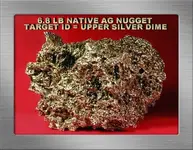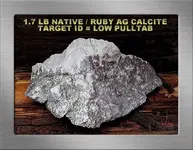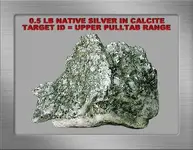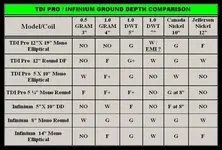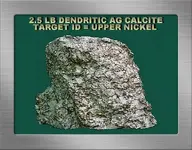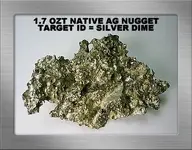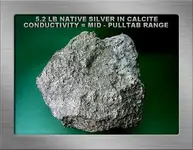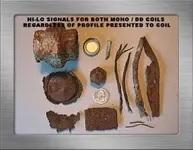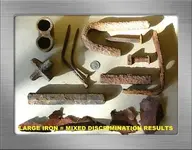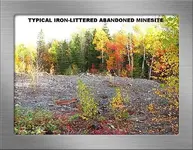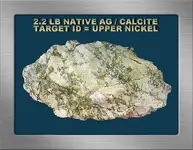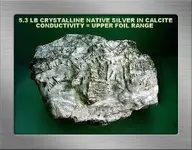Jim Hemmingway
Hero Member
- #1
Thread Owner
The Garrett Infinium LS in the Silverfields of Northeastern Ontario-Revised 04-2015
Introduction
The native silver in this area is intimately associated with cobalt-nickel arsenide deposits. Native silver ranging up to 95% purity, acanthite, pyrargyrite and proustite ruby silvers, stephanite, and other collectable silver minerals occur in calcite or carbonate veins sometimes with quartz, fluorite, barite and many other minerals normally associated with epithermal deposits. Silver ores and nuggets found here in northeastern Ontario share a similar conductive range to gold. The similarity mainly results from factors such as purity, the type of mineral inclusions, size, shape, and structure.
Mineral collectors find native silver primarily in the form of specimens, and these typically are comprised of silver in calcite or dolomite, or in a cobalt-nickel arsenide mass, and sometimes attached to diabase and other rock types frequently as plate silver. Light-hued pink or creamy white calcite silver specimens are highly valued, as much or more than silver nuggets depending on structure. Structure refers to how the silver is formed, examples include various dendritic patterns, plate, disseminated, sponge, and generally massive formations. Nuggets are much less prevalent than specimen silver but are still occasionally found by electronic prospectors. The photo below depicts a large native silver nugget of high purity. It responds to the Garrett Infinium with a high conductive ‘lo-hi’ signal in zero discrimination and with a low conductive ‘hi-lo’ signal in reverse discrimination. Reverse discrimination may also be referred to as the ‘iron check’ mode in this report.
The Infinium is a pulse induction unit designed to search anywhere in or out of the water. Searching for native silver is a unique application of this detector. It is a suitable alternative for searching highly mineralized ground found in mining country where VLF performance struggles with increased levels of non-conductive, magnetic susceptible iron mineralizations. The search conditions present quite a challenge for any detector that will encounter non-conductive, iron-mineralized hotrocks, conductive pyrrhotite and other electrically conductive but undesirable arsenides or sulfides, proliferate rusted iron waste, and non-ferrous trash residing in variable strength ferromagnetic substrates. Such difficult conditions effectively conceal valuable silver ores, but these should be viewed as a good thing since otherwise there would soon be very little silver for hobbyists to find.
For general searching, particularly in high magnetic susceptible mafic conditions, the 14” elliptical mono coil is normally used where trash levels are tolerable, to achieve maximum depth and coverage. Otherwise the 8” round mono coil is an excellent tool for good depth performance over a wide range of target sizes at variable depths in this application, more on this subject later. Keep in mind that we’re discussing relatively large multi-pound-ounce silver and not typical small sub-gram gold pursuits.
Frankly I was delighted with the performance of this economically priced unit in silver country. Infinium’s internal electronic platform is operating simplicity itself, but highly effective at distinguishing silver from elongated iron… a good indication that the designers are familiar with prospecting conditions. Two very convenient physical attributes include waterproofing of the electronics package, and a power supply employing eight regular or rechargeable ‘AA’ batteries that are quick and easy to install. Infinium currently has five different coils available that include DD and mono selections. There are several possible configurations to mount the electronic package on the stem, it comes supplied with a belt and pouch for hip mounting, and includes both an AC charger and an auto charger. The standard supplied headphones can be replaced by substituting a dongle-dude that permits using your favorite headphones.
This report looks closely at Infinium’s tone ID system and reverse discrimination feature. It describes how these can be used to advantage to separate silver ores from some high conductive iron targets when searching abandoned minesites where iron waste is normally abundant. The Infinium is an excellent prospecting unit for this application and found a previously unmatched quantity of beautiful silver for me this past autumn.
The photo above depicts an attractive native-ruby silver specimen found at the abandoned mining camp shown below during the early part of the autumn prospecting season. Many pounds of beautiful native silver have been found in this particular area, including fine examples of the deep ruby silver pyrargyrite embedded in creamy-white calcite or in a dolomite host. In fact the first season that Infinium was employed in silver country netted in excess of 18 lbs of ruby silver ores in close association with native silver. These doubtless constituted an inadvertently misgraded deposit in the waste tailings disposal area… within the view offered by this photo.
Control Adjustments and Observations
Ground balancing was quick and easy to achieve over any ground encountered in the area using the 14” mono coil. The heavier, less sensitive 14” DD elliptical coil was not required to achieve proper ground balance here. The discrimination control is set to zero prior to ground-balancing, with the threshold set to a barely discernable volume level. Several pumps of the coil are normally sufficient to achieve ground balance in either the fast or slow track settings. Searching with the ground balance set to fast or slow tracking modes is an option over variable harsh ground mineral conditions. Otherwise Garrett recommends the ground balance control be set to the ‘lock’ position to “maximize detection depth”. There was no need to adjust the ground balance over any sites searched, but the ground balance procedure was repeated whenever changing locations as a matter of habit. Search in zero discrimination for best depth and sensitivity to low conductives, and check questionable signals in reverse (iron check) discrimination.
The Infinium is a highly stable instrument that hums right along with smooth quiet performance. At home it will satisfactorily reduce or eliminate high residential EMI induced instability such that test signals can be evaluated even in the house. No discrimination was required to achieve operating stability at any time. The frequency shift control was not adjusted either, there was simply no need to do so in remote prospecting locations away from EMI sources.
The threshold control, aside from its frequency adjustment function in the maximum clockwise position, also serves as an adjustable audio boost. Increasing the threshold beyond a barely discernible volume enables hearing signals at improved depths. A bare threshold volume is a setting of “4” or a bit less, but I usually set it to about 6ish or even slightly higher to enhance deeper target signals. To compensate for the higher threshold volume, the headphone volume can be reduced to personal preference.
This set-up will permit hearing deeper signals that would otherwise go undetected. For example, Infinium with the 14” elliptical mono coil and using a barely discernible threshold hum was tested over some pre-1981 Canada nickels. For your information, pre-1981 Canada nickels do not respond nearly so well to PI units as do Jefferson nickels that air test to almost double the distance. These Canada nickels are buried in highly mineralized ground at various depths ranging up to ten (10) inches. Only a 6” nickel responds with a solid repeatable signal. An 8” nickel usually gives a light repeatable signal but sometimes responds with a one-way signal and might easily be overlooked. But by increasing the threshold setting to about “6” or more, a Canada nickel at 10 inches depth responds nicely with a solid, repeatable signal with some coil to ground distance to spare.
The photo below depicts my first silver find using the Infinium, retrieved a foot deep into a hillside. It responded with a solid hi-lo signal in zero discrimination and again in reverse discrimination with a reduced signal volume. That depth is accurate, as this trip all holes were dug using only my small rock pick-hammer. I had injured my shoulder recently, and could not carry the large Estwing pick I’ve used for the past 25 years.
I was very pleased with Infinium’s quiet stability over any ground, and overall depth performance on a range of target conductivities and target sizes from a half-gram on up to multiple lbs. In fact, the second decent target signal of the trip was a solid one-gram nugget found at several inches depth using the 14” mono coil …it was getting dark so I couldn't be sure just how deep it was located. This nickel-conductive range nugget was reburied back at camp at about four (4) inches depth resulting in a strong hi-lo signal. I felt certain it could be had significantly deeper.
Infinium & TDI Pro Depth Comparison
Operated at bare thresholds the TDI Pro is a noticeably deeperseeking and more sensitive unit. As noted above, the Garrett Infinium’s depth / sensitivity is vastly improved by adjusting the threshold control up to 6ish or slightly more and adjusting headphone volume to preference. With this adjustment to Infinium there is little or no difference between these units regarding depth / sensitivity over a variety of target sizes buried at variable depths in my testplot. There is some variability between different types and sizes of coils of course. We see that large coils tend to be deeperseeking on larger targets and less sensitive to shallower small stuff and vice-versa for small coils. Mono coils are deeperseeking compared to similar size DD coils in this moderately tough ground.
Now let’s look at some low conductive target responses presented in the chart below. As noted above, the majority of silver ores are low conductive. Keep in mind these depths do not represent the full capability of these units. Using solid lead “nuggets” instead of gold or silver nuggets, the fact that they’re freshly buried, and rather severe local EMI conditions all contrive to reduce detection depth compared to silver or gold nuggets naturally settled in the field. But they do work just fine for relative side-by-side depth comparisons between these units.
For this comparison, Infinium threshold is set slightly above six (6), employs zero discrimination, with the ground balance control locked after ground-balancing the unit. The TDI Pro is manually ground-balanced at just below GB9, set to near maximum gain, with a 10-usec-pulse delay and a bare threshold. The chart designations indicate Weak, Fair, and Good signal responses.
I tend to compare the 8” Infinium round mono to the TDI designed Razorback 5 X 10” elliptical mono, and the Infinium 10” X 14” elliptical mono to the TDI Pro 12” DF round stock coil because these are comparable sizes. I think we can agree that the results are fairly close, the variances are likely due to the coils tested. I see no significant advantage either way on these low conductive targets, but certainly the Infinium 8” round mono searchcoil performs very well over the entire target size / depth range.
Both these units have been used extensively in the field for several autumn prospecting seasons. Operating as described, I’ve not noticed any discernable depth difference between them.
To place the chart into a sensible perspective, we should note that there are a number of factors that affect depth results at any given time or place. These factors include magnetic susceptible iron minerals, disturbed or undisturbed soil conditions, soil moisture, electromagnetic (EMI) interference, physical / chemical characteristics of a target, detector settings, operator skill and so forth. It’s not unusual to encounter situations where a deep target in the test plot can easily be had one week, while the following week it is difficult to acquire a decent signal from the same target. The only factors that could have changed are soil moisture and EMI levels.
Size and shape notwithstanding, nugget structure or ‘character’ is a decisive factor as to whether Infinium will or not respond to smaller nuggets. The one-gram piece noted above is compact and solid. I have many similar size nuggets with more “character” that respond poorly to Infinium by comparison. Some will barely signal even when rubbed on the coil. I suspect many such nuggets go unnoticed by PI users, except those using recent offering from Minelab such as the SDC 2300 PI unit.
Small Shallow Silver PI Signals
We sometimes read about hobbyists claiming that nuggets in the ground react with a stronger signal to their PI units than those same nuggets produce once on the surface or waved across the coil. Some occasionally claim that no air test signal can be had on a piece that obviously responded with a signal when in the ground. From my repeated experiences with the TDI Pro and Garrett Infinium I have no doubt these accounts are factual.
But there are plenty of samples dug from various depths that do not react similarly. For example, the deeper, larger solid structure silver ores produce weak signals entirely due to depth, but when brought to the surface these same pieces of course produce a very strong signal.
One could postulate that there is a combination of factors such as size, shape, structure and depth that determine differences in signal strength for any given target once brought to and scanned on the surface. My observation is that signal strength loss on the surface seems to be restricted to smaller shallow silver and sometimes it occurs with slightly larger ‘high character’ or spongy silver a bit deeper. A decent size piece is anticipated based on the signal strength, only to dig it and find that a perfectly good signal was produced by small or sponge silver whose surface signal has lost considerable strength or nearly vanished. Occasionally the signal is lost altogether… requiring my Propointer to locate such targets.
The photo below depicts a large dendritic 2½ lb native silver specimen. It responds with a solid hi-lo signal in zero discrimination, and a much quieter hi-lo signal in reverse discrimination. It was recovered at arm’s length with my shoulder reaching into the hole. This was tough digging in a difficult concrete-like rock matrix that might have gone on much longer were it not for using my new Garrett Propointer. The Propointer is a fairly tough, water-resistant tool ideally sensitive for effectively pinpointing multiple targets in the same hole and no worries about rough treatment.
Infinium in the Field
Prospecting means operating with the Infinium configured to achieve best possible depth. It should be run at zero discrimination with the tracking feature set to the ‘lock’ position subsequent to ground-balancing. By occasionally bobbing the coil you can check the ground balance and reset it where necessary. The threshold can be set at a barely heard ‘hum’ or can be increased enabling deeper targets to signal than would otherwise be possible at lower threshold settings. Headphone volume can be set to preference to accommodate higher threshold volume levels.
Best depth and sensitivity is achieved by using a slow coil sweep speed. How slow is slow? Experiment by burying an appropriate target at a reasonable depth and determine the sweep speed that gives the best depth results. Slow, no more than one or two feet per second is recommended by Garrett.
In zero discrimination the vast majority of silver ores will signal with a low conductive hi-lo signal. All targets, ferrous or non-ferrous, that dwell within a conductivity range up to and including fringe zinc penny level respond with a hi-lo signal. Beyond that conductive level, all targets respond with a lo-hi signal in zero discrimination.
In reverse discrimination, all ferrous and non-ferrous targets that dwell within an expanded conductivity range up to and including silver dime level will respond with a hi-lo signal. All targets that dwell in a conductivity range above silver dime level will respond with a lo-hi signal. Obviously any zero discrimination lo-hi targets existing in a narrow high conductive window between fringe zinc penny level and silver dime level will reverse their tones in reverse discrimination to respond as hi-lo signals. Reverse discrimination lo-hi signals in a prospecting context represent iron targets for all practical purposes. High conductive silver that will respond with a lo-hi signal in reverse discrimination is almost non-existent in this area.
The attractive silver nugget illustrated in the photo below fits into the ‘conductive window’ just described. It responds with a lo-hi signal in zero discrimination and a weak hi-lo signal in reverse discrimination. It also combines good “character” with very high conductivity, a unique and rare find.
Zero discrimination hi-lo signals, hi-lo signals that disappear in reverse discrimination, and reverse discrimination hi-lo signals must all be dug to avoid losing good targets. If you have good reason to think there are desirable targets beyond the silver dime range, then you must dig reverse discrimination lo-hi signals. There are instances where you must use some judgement, and it would be foolish to ignore broad weak signals that indicate a large target at depth. Always remember that adjacent high conductive iron trash could very well influence the weak signal produced, and that no target ID tone system is infallible. But in trashy areas, weigh that consideration against the likelihood that you will expend considerable effort digging high conductive iron junk reverse discrimination lo-hi signals, when you could have been covering far more ground digging more likely signals that produce hi-lo signals in both zero and reverse discrimination. To reiterate… high conductive silver that produces a lo-hi reverse discrimination signal is extremely rare, so weigh your options carefully in the field to achieve consistent productive results.
To ensure effective target ID, always sweep the coil over a target from different directions. Any target that gives both hi-lo and lo-hi signals is definitely elongated iron. Elongated iron will give a lo-hi or double lo-hi signal along its length and normally a hi-lo signal across its width.
Low conductive iron in this report refers to all iron junk that dwells within the low conductive range as described above and signals with a hi-lo tone regardless of target profile to the coil. Low conductive iron is very difficult to distinguish from low conductive silver because target size and target depths are highly variable factors. Infinium’s reverse discrimination concept of reduced signal volume over non-ferrous targets is a useful indicator to distinguish larger iron from silver ores. However, smaller low conductive iron can lose signal volume in reverse discrimination similar to low conductive silver. By comparison, solidly structured larger high conductive silver tends to retain its volume in reverse discrimination. The reverse discrimination concept of reduced signal volume over non-ferrous targets is not a definitive technique and should be regarded as an indicator only.
The photo below depicts a large dendritic silver specimen that responded strongly as a hi-lo signal in zero discrimination, but in reverse discrimination the hi-lo signal volume was quite reduced as were most conductive ores. This target was only down a foot in fairly tough mineral ground.
More About Iron
We have described target classification above as an overview. Lets look at some iron photos and relate these types of iron junk to the signals they produce. Keep in mind that silver ores do not change signals in the field. They are in a fixed position, are not both magnetic and conductive like iron, and therefore normally respond uniformly regardless of how the coil is manipulated. Low conductive iron as described in this report, fits into the same category. It gives a hi-lo signal in both zero or reverse discrimination regardless of profile to the coil. Low conductive iron is difficult to separate from low conductive silver for reasons described above, so I won’t repeat them again here.
Examples of low conductive iron junk as depicted in the photo below include rusty small iron tidbits, small flat, thin sheet iron and tin, twisted or braided iron wire of any diameter, small nuts and small nut and bolt combos, small ¼ inch iron plate, rusted jar lids and so forth. Very short twisted iron cables of any diameter are a real nuisance because the length is insufficient to identify them as can be done on longer pieces. All these give hi-lo signals in zero and reverse discrimination.
Some large high conductive iron encountered in the field exists exclusively above the silver dime conductivity level and is definitively identified by Infinium’s tones. It yields lo-hi signals in zero and reverse discrimination regardless of profile to the coil. There is a tendency for very large, thick nails or spikes in the 8’ to 12” range, flat / thick and / or elongated plate iron, and larger drill bits to fit into this category.
The vast majority of high conductive iron is solid, elongated iron of nearly any size from nails to drill bit rods and even larger bars and broken implements. Most of these give a lo-hi signal along the length but produce a hi-lo signal when the coil is swept across their width in both zero and reverse discrimination. The photo below gives you a bit of an idea about the variety of typical, larger iron that is commonly encountered in mining country. The three pieces along the bottom are low conductive, thin pieces of sheet iron. The remaining examples in the photo are high conductive iron.
The Infinium mono coils improve iron identification reliability over the DD coils. Some lo-hi reverse discrimination iron signals on the mono coils will respond as hi-lo signals on the DD coils. Some elongated iron will signal entirely as hi-lo signals with the DD in reverse discrimination. How much is the difference? The DD coils misidentify about 15% of my tested iron samples. But these tests do not represent proportions encountered in the field, so that figure is an estimate only. The mono coils have handled all highly magnetic susceptible substrates here quite well, the 14” mono is lighter than the 14” DD, the mono coils are deeperseeking and are more sensitive to small targets than DD coils. And as noted, the mono coils are more effective iron discriminators than the DD coils. Unless ground minerals require using the DD coils, I strongly suggest sticking with the mono coils for these advantageous reasons.
Have a look at the photo below. This scene was not set-up in any way. It was mere happenstance that I was there and snapped a photo on the chance that it might come in handy later. Look at the visible large iron. What we don’t see are the countless rusty nails, bolts and nuts, washers, wire and so forth that abound mostly on the surface. A good deal more iron lurks immediately beneath the surface. An operator has to scout around to find a spot clear of iron to ground balance a larger size coil at this site.
This area was searched with the large and smaller mono elliptical coils but it was pretty much a wasted effort. While the smaller 5”X 10” DD coil does not generate similar depth results, it does better at navigating in-and-around abundant iron junk. As an alternative try using a suitable VLF unit at trashy sites. An MXT or F75 using a DD coil and / or a smaller coil will produce results in these conditions. It is better to find some silver than to walk away from a site frustrated with no silver.
How Does Infinium Discrimination Work?
The following is my view of the Infinium discrimination system. Yes, it’s guesswork, but it’s in complete accord with my firsthand experience. Garrett has not been contacted for a technical explanation because they would not likely give one for proprietary reasons.
At zero discrimination, all substrates in this area ground balance near the lower zinc penny range. Therefore, all target conductivities up to the fringe of zinc penny range fall into the low conductive hi-lo tone range. Targets that lie above that ground balance point will be high conductive lo-hi tones.
The Infinium’s adjustable discrimination up to and including the reverse discrimination / iron check position is an adjustable pulse delay control. The iron check position represents the longest pulse delay available. At this pulse delay setting the effect is to adjust the GB point such that silver dime conductive level is now included into the low conductive hi-lo tone range. This enlarged low conductive hi-lo tone range will also include any iron that falls into it. Since the GB is not manually adjustable, the unit’s software or circuitry adjusts it automatically to compensate for any change in the discrimination (pulse) delay control setting.
There is no other satisfactory explanation for the lo-hi signals between zinc penny and silver dime range that switch over to become hi-lo signals when using the reverse discrimination / iron check setting. So, we’ll stick with this reasoning for now. Another interesting point is that we should expect to see diminished depths on targets that ground balance close to the soil GB point near the lower zinc penny range.
In addition to potential tone ID changeovers in the reverse discrimination / iron check mode, the other significant aspect of the iron check concept is related to a reduction in signal volume over some targets… particularly the low conductives. As described above under Infinium in the Field, signal volume reduction should be used strictly as an indicator rather than as a definitive technique to determine whether to dig or not to dig. Most silver ores produce a reduced signal volume in reverse discrimination compared to most of the high conductive iron in the photo. Sub-pound weight silver signals generally are quite subdued or disappear entirely in reverse discrimination. This depends partially on target depth as well. It’s not foolproof, but provides a pretty good idea when you can dig with enthusiasm. Below is a handsome little specimen that, while not sub-pound in weight, its signal nearly disappears in reverse discrimination.
So, let’s summarize what this boils down to in the field…
Zero discrimination hi-lo tones on silver ores will always be hi-lo tones in the reverse discrimination / iron check mode unless the signal tone disappears altogether. Dig both these types of signal responses without fail.
Some high conductive lo-hi tones in zero discrimination will change over to become low conductive hi-lo tones in reverse discrimination. These include both iron and desirable non-ferrous targets. Dig all hi-lo tones in reverse discrimination to avoid losing good silver.
Use some judgement about digging broad, weak reverse discrimination lo-hi signals. Such silver is extremely rare, but you may wish to investigate such signals in less trashy areas.
There are always conditions in the field that may dictate utilizing the Infinium’s discrimination or tone feature in a different manner. We know that in reverse discrimination all zero discrimination lo-hi tone targets, ferrous and non-ferrous, within a range bordered by fringe zinc penny up to and including silver dime conductive levels will change tone to become hi-lo tone signals. High conductive iron is far more plentiful than high conductive silver in this limited range. To avoid digging this iron in trashy sites, you may prefer to stick with zero discrimination tones only. The trade-off is the rather low odds of ignoring a very high conductive piece of silver. This strategy frees up a lot of time to cover a lot more ground. Reverse discrimination hi-lo signals should otherwise be dug, and especially should not be ignored in gold country.
The photo below depicts a solidly structured native silver nugget found many years ago. It’s an excellent example of silver at the silver dime conductive level that gives a lo-hi tone in zero discrimination and a fairly strong hi-lo signal in reverse discrimination due to its high conductivity, large size, and solid structure.
Summary
The Infinium identifies high and low conductives conveniently without involved manipulation of the controls to identify some high conductive iron. At zero discrimination high conductives give a lo-hi signal and low conductives give a hi-lo signal. Infinium automatically performs this task and does so to its detection depth limit. But it should be noted that at its depth threshold, it will occasionally default to a hi-lo signal. At least this ensures the target will be investigated… in several instances as digging reduced the coil to target distance, the hi-lo signal changed over to a lo-hi signal… accurately identifying large high conductive iron. As previously noted, invoking reverse discrimination definitively identifies a good portion of high conductive iron when employed in a prospecting context. And let’s reiterate that if you are willing to forego an infrequent silver piece above fringe zinc penny conductive level, all high conductive iron can be identified by means of the zero discrimination lo-hi tones.
There are many areas in mining country where there is an abundance of what might be described as “VLF background noise”. This noise is the result of spurious ground signals from whatever mineralizations and targets that are present at various depths. Non-conductive ferromagnetic hotrocks, small low conductive pyrrhotite, iron trash, and remnants of other electrically conductive ores such as safflorite, cobaltite, skutterudite, arsenopyrite, niccolite, copper sulfides and other minerals associated with epithermal deposits. Amidst these undesirable signals exist randomly scattered silver nuggets and ores at variable depths.
VLF operators tend to ignore much of the spurious noise that survives even small iron discrimination settings while intent on locating “discrete” signals. In quieter ground such signals might be investigated, but in extremely busy ground they are mostly ignored. It just isn't worth the time and effort to investigate broken or ticky signals.
Infinium’s pulse induction electromagnetic field penetrates deeply and occasionally locks on to some of those indistinguishable VLF noises, generating an unmistakable “discrete” hi-lo or lo-hi signal. Some of those signals are unwanted, but some are large, deep or otherwise handsome silver. This capability represents Infinium’s best performance feature since it directly resulted in finding big deep silver.
Below is a fine example of such big, deep silver in the form of an exquisitely crystalline native silver specimen found this past autumn with Infinium. I am almost certain it was swept with my VLF unit the previous year, notwithstanding countless others over several decades. But Infinium, equipped with a 14” elliptical mono coil, responded to it with a quiet but unmistakable hi-lo signal. This is an especially valuable prize found at shoulder-in-the-hole depth.
Infinium’s second most prominent feature was its ability to segregate considerable iron that has plagued my VLF units as “diggable” signals for many years. Four-inch rail spikes and five-inch long drill-bit rods are a particular nuisance to VLF units when located at depth, but Infinium easily identified these by their tone ID signals. I did not mind digging the hi-lo iron not identified by Infinium, because a good portion would have been misidentified by my VLF units requiring at least partial investigation anyway.
Adjusting the discrimination control is convenient when using a hipmount configuration, but after a week or so the coil cable connection to the unit body became stressed to the point of generating constant false signals. This necessitated mounting the electronics package under the armcuff to eliminate the cable stress. It became instantly inconvenient to adjust this control. I suggest Garrett consider mounting an ‘iron check’ button right on the handle for operator convenience.
There should be some additional stem length behind the elbow to attach the electronics package further back on the stem to improve overall balance. Its present configuration, mounted next to the handle, is very weight-forward and feels terribly heavy… a ridiculously unnecessary strain on the arm and shoulder.
Finally, I suggest a complete solid stem that hobbyists expect with any detector purchase, rather than the present scheme that involves attaching two stem pieces that result in a flimsy, disjointed stem ‘wiggle’. Most hobbyists do not use the Infinium for scuba diving, so please eliminate this nonsense by offering an additional scuba short-stem as an accessory. Too many hobbyists including me have felt it necessary to purchase aftermarket stems to replace the original inappropriate product. These are likely more expensive ($165 delivered to the door) than the cost Garrett would pass on to customers for providing a properly designed stem.
That said, the Garrett Infinium is without doubt the most effective instrument I’ve used in 25 years for this application. Its depth performance on typical size native silver ores is often more deeperseeking than some hobbyists might wish to dig into difficult rocky substrates. As described earlier in the report Infinium excels at separating silver and other conductive ores from some high conductive iron at good depths… a real time and work saver!!! Thankyou to everyone for taking the time to get through this revised report.
Jim Hemmingway
April 2015
The Garret Infinium LS in the Silverfields of Northeastern Ontario
Revised Edition – April 2015
Revised Edition – April 2015
Introduction
The native silver in this area is intimately associated with cobalt-nickel arsenide deposits. Native silver ranging up to 95% purity, acanthite, pyrargyrite and proustite ruby silvers, stephanite, and other collectable silver minerals occur in calcite or carbonate veins sometimes with quartz, fluorite, barite and many other minerals normally associated with epithermal deposits. Silver ores and nuggets found here in northeastern Ontario share a similar conductive range to gold. The similarity mainly results from factors such as purity, the type of mineral inclusions, size, shape, and structure.
Mineral collectors find native silver primarily in the form of specimens, and these typically are comprised of silver in calcite or dolomite, or in a cobalt-nickel arsenide mass, and sometimes attached to diabase and other rock types frequently as plate silver. Light-hued pink or creamy white calcite silver specimens are highly valued, as much or more than silver nuggets depending on structure. Structure refers to how the silver is formed, examples include various dendritic patterns, plate, disseminated, sponge, and generally massive formations. Nuggets are much less prevalent than specimen silver but are still occasionally found by electronic prospectors. The photo below depicts a large native silver nugget of high purity. It responds to the Garrett Infinium with a high conductive ‘lo-hi’ signal in zero discrimination and with a low conductive ‘hi-lo’ signal in reverse discrimination. Reverse discrimination may also be referred to as the ‘iron check’ mode in this report.
The Infinium is a pulse induction unit designed to search anywhere in or out of the water. Searching for native silver is a unique application of this detector. It is a suitable alternative for searching highly mineralized ground found in mining country where VLF performance struggles with increased levels of non-conductive, magnetic susceptible iron mineralizations. The search conditions present quite a challenge for any detector that will encounter non-conductive, iron-mineralized hotrocks, conductive pyrrhotite and other electrically conductive but undesirable arsenides or sulfides, proliferate rusted iron waste, and non-ferrous trash residing in variable strength ferromagnetic substrates. Such difficult conditions effectively conceal valuable silver ores, but these should be viewed as a good thing since otherwise there would soon be very little silver for hobbyists to find.
For general searching, particularly in high magnetic susceptible mafic conditions, the 14” elliptical mono coil is normally used where trash levels are tolerable, to achieve maximum depth and coverage. Otherwise the 8” round mono coil is an excellent tool for good depth performance over a wide range of target sizes at variable depths in this application, more on this subject later. Keep in mind that we’re discussing relatively large multi-pound-ounce silver and not typical small sub-gram gold pursuits.
Frankly I was delighted with the performance of this economically priced unit in silver country. Infinium’s internal electronic platform is operating simplicity itself, but highly effective at distinguishing silver from elongated iron… a good indication that the designers are familiar with prospecting conditions. Two very convenient physical attributes include waterproofing of the electronics package, and a power supply employing eight regular or rechargeable ‘AA’ batteries that are quick and easy to install. Infinium currently has five different coils available that include DD and mono selections. There are several possible configurations to mount the electronic package on the stem, it comes supplied with a belt and pouch for hip mounting, and includes both an AC charger and an auto charger. The standard supplied headphones can be replaced by substituting a dongle-dude that permits using your favorite headphones.
This report looks closely at Infinium’s tone ID system and reverse discrimination feature. It describes how these can be used to advantage to separate silver ores from some high conductive iron targets when searching abandoned minesites where iron waste is normally abundant. The Infinium is an excellent prospecting unit for this application and found a previously unmatched quantity of beautiful silver for me this past autumn.
The photo above depicts an attractive native-ruby silver specimen found at the abandoned mining camp shown below during the early part of the autumn prospecting season. Many pounds of beautiful native silver have been found in this particular area, including fine examples of the deep ruby silver pyrargyrite embedded in creamy-white calcite or in a dolomite host. In fact the first season that Infinium was employed in silver country netted in excess of 18 lbs of ruby silver ores in close association with native silver. These doubtless constituted an inadvertently misgraded deposit in the waste tailings disposal area… within the view offered by this photo.
Control Adjustments and Observations
Ground balancing was quick and easy to achieve over any ground encountered in the area using the 14” mono coil. The heavier, less sensitive 14” DD elliptical coil was not required to achieve proper ground balance here. The discrimination control is set to zero prior to ground-balancing, with the threshold set to a barely discernable volume level. Several pumps of the coil are normally sufficient to achieve ground balance in either the fast or slow track settings. Searching with the ground balance set to fast or slow tracking modes is an option over variable harsh ground mineral conditions. Otherwise Garrett recommends the ground balance control be set to the ‘lock’ position to “maximize detection depth”. There was no need to adjust the ground balance over any sites searched, but the ground balance procedure was repeated whenever changing locations as a matter of habit. Search in zero discrimination for best depth and sensitivity to low conductives, and check questionable signals in reverse (iron check) discrimination.
The Infinium is a highly stable instrument that hums right along with smooth quiet performance. At home it will satisfactorily reduce or eliminate high residential EMI induced instability such that test signals can be evaluated even in the house. No discrimination was required to achieve operating stability at any time. The frequency shift control was not adjusted either, there was simply no need to do so in remote prospecting locations away from EMI sources.
The threshold control, aside from its frequency adjustment function in the maximum clockwise position, also serves as an adjustable audio boost. Increasing the threshold beyond a barely discernible volume enables hearing signals at improved depths. A bare threshold volume is a setting of “4” or a bit less, but I usually set it to about 6ish or even slightly higher to enhance deeper target signals. To compensate for the higher threshold volume, the headphone volume can be reduced to personal preference.
This set-up will permit hearing deeper signals that would otherwise go undetected. For example, Infinium with the 14” elliptical mono coil and using a barely discernible threshold hum was tested over some pre-1981 Canada nickels. For your information, pre-1981 Canada nickels do not respond nearly so well to PI units as do Jefferson nickels that air test to almost double the distance. These Canada nickels are buried in highly mineralized ground at various depths ranging up to ten (10) inches. Only a 6” nickel responds with a solid repeatable signal. An 8” nickel usually gives a light repeatable signal but sometimes responds with a one-way signal and might easily be overlooked. But by increasing the threshold setting to about “6” or more, a Canada nickel at 10 inches depth responds nicely with a solid, repeatable signal with some coil to ground distance to spare.
The photo below depicts my first silver find using the Infinium, retrieved a foot deep into a hillside. It responded with a solid hi-lo signal in zero discrimination and again in reverse discrimination with a reduced signal volume. That depth is accurate, as this trip all holes were dug using only my small rock pick-hammer. I had injured my shoulder recently, and could not carry the large Estwing pick I’ve used for the past 25 years.
I was very pleased with Infinium’s quiet stability over any ground, and overall depth performance on a range of target conductivities and target sizes from a half-gram on up to multiple lbs. In fact, the second decent target signal of the trip was a solid one-gram nugget found at several inches depth using the 14” mono coil …it was getting dark so I couldn't be sure just how deep it was located. This nickel-conductive range nugget was reburied back at camp at about four (4) inches depth resulting in a strong hi-lo signal. I felt certain it could be had significantly deeper.
Infinium & TDI Pro Depth Comparison
Operated at bare thresholds the TDI Pro is a noticeably deeperseeking and more sensitive unit. As noted above, the Garrett Infinium’s depth / sensitivity is vastly improved by adjusting the threshold control up to 6ish or slightly more and adjusting headphone volume to preference. With this adjustment to Infinium there is little or no difference between these units regarding depth / sensitivity over a variety of target sizes buried at variable depths in my testplot. There is some variability between different types and sizes of coils of course. We see that large coils tend to be deeperseeking on larger targets and less sensitive to shallower small stuff and vice-versa for small coils. Mono coils are deeperseeking compared to similar size DD coils in this moderately tough ground.
Now let’s look at some low conductive target responses presented in the chart below. As noted above, the majority of silver ores are low conductive. Keep in mind these depths do not represent the full capability of these units. Using solid lead “nuggets” instead of gold or silver nuggets, the fact that they’re freshly buried, and rather severe local EMI conditions all contrive to reduce detection depth compared to silver or gold nuggets naturally settled in the field. But they do work just fine for relative side-by-side depth comparisons between these units.
For this comparison, Infinium threshold is set slightly above six (6), employs zero discrimination, with the ground balance control locked after ground-balancing the unit. The TDI Pro is manually ground-balanced at just below GB9, set to near maximum gain, with a 10-usec-pulse delay and a bare threshold. The chart designations indicate Weak, Fair, and Good signal responses.
I tend to compare the 8” Infinium round mono to the TDI designed Razorback 5 X 10” elliptical mono, and the Infinium 10” X 14” elliptical mono to the TDI Pro 12” DF round stock coil because these are comparable sizes. I think we can agree that the results are fairly close, the variances are likely due to the coils tested. I see no significant advantage either way on these low conductive targets, but certainly the Infinium 8” round mono searchcoil performs very well over the entire target size / depth range.
Both these units have been used extensively in the field for several autumn prospecting seasons. Operating as described, I’ve not noticed any discernable depth difference between them.
To place the chart into a sensible perspective, we should note that there are a number of factors that affect depth results at any given time or place. These factors include magnetic susceptible iron minerals, disturbed or undisturbed soil conditions, soil moisture, electromagnetic (EMI) interference, physical / chemical characteristics of a target, detector settings, operator skill and so forth. It’s not unusual to encounter situations where a deep target in the test plot can easily be had one week, while the following week it is difficult to acquire a decent signal from the same target. The only factors that could have changed are soil moisture and EMI levels.
Size and shape notwithstanding, nugget structure or ‘character’ is a decisive factor as to whether Infinium will or not respond to smaller nuggets. The one-gram piece noted above is compact and solid. I have many similar size nuggets with more “character” that respond poorly to Infinium by comparison. Some will barely signal even when rubbed on the coil. I suspect many such nuggets go unnoticed by PI users, except those using recent offering from Minelab such as the SDC 2300 PI unit.
Small Shallow Silver PI Signals
We sometimes read about hobbyists claiming that nuggets in the ground react with a stronger signal to their PI units than those same nuggets produce once on the surface or waved across the coil. Some occasionally claim that no air test signal can be had on a piece that obviously responded with a signal when in the ground. From my repeated experiences with the TDI Pro and Garrett Infinium I have no doubt these accounts are factual.
But there are plenty of samples dug from various depths that do not react similarly. For example, the deeper, larger solid structure silver ores produce weak signals entirely due to depth, but when brought to the surface these same pieces of course produce a very strong signal.
One could postulate that there is a combination of factors such as size, shape, structure and depth that determine differences in signal strength for any given target once brought to and scanned on the surface. My observation is that signal strength loss on the surface seems to be restricted to smaller shallow silver and sometimes it occurs with slightly larger ‘high character’ or spongy silver a bit deeper. A decent size piece is anticipated based on the signal strength, only to dig it and find that a perfectly good signal was produced by small or sponge silver whose surface signal has lost considerable strength or nearly vanished. Occasionally the signal is lost altogether… requiring my Propointer to locate such targets.
The photo below depicts a large dendritic 2½ lb native silver specimen. It responds with a solid hi-lo signal in zero discrimination, and a much quieter hi-lo signal in reverse discrimination. It was recovered at arm’s length with my shoulder reaching into the hole. This was tough digging in a difficult concrete-like rock matrix that might have gone on much longer were it not for using my new Garrett Propointer. The Propointer is a fairly tough, water-resistant tool ideally sensitive for effectively pinpointing multiple targets in the same hole and no worries about rough treatment.
Infinium in the Field
Prospecting means operating with the Infinium configured to achieve best possible depth. It should be run at zero discrimination with the tracking feature set to the ‘lock’ position subsequent to ground-balancing. By occasionally bobbing the coil you can check the ground balance and reset it where necessary. The threshold can be set at a barely heard ‘hum’ or can be increased enabling deeper targets to signal than would otherwise be possible at lower threshold settings. Headphone volume can be set to preference to accommodate higher threshold volume levels.
Best depth and sensitivity is achieved by using a slow coil sweep speed. How slow is slow? Experiment by burying an appropriate target at a reasonable depth and determine the sweep speed that gives the best depth results. Slow, no more than one or two feet per second is recommended by Garrett.
In zero discrimination the vast majority of silver ores will signal with a low conductive hi-lo signal. All targets, ferrous or non-ferrous, that dwell within a conductivity range up to and including fringe zinc penny level respond with a hi-lo signal. Beyond that conductive level, all targets respond with a lo-hi signal in zero discrimination.
In reverse discrimination, all ferrous and non-ferrous targets that dwell within an expanded conductivity range up to and including silver dime level will respond with a hi-lo signal. All targets that dwell in a conductivity range above silver dime level will respond with a lo-hi signal. Obviously any zero discrimination lo-hi targets existing in a narrow high conductive window between fringe zinc penny level and silver dime level will reverse their tones in reverse discrimination to respond as hi-lo signals. Reverse discrimination lo-hi signals in a prospecting context represent iron targets for all practical purposes. High conductive silver that will respond with a lo-hi signal in reverse discrimination is almost non-existent in this area.
The attractive silver nugget illustrated in the photo below fits into the ‘conductive window’ just described. It responds with a lo-hi signal in zero discrimination and a weak hi-lo signal in reverse discrimination. It also combines good “character” with very high conductivity, a unique and rare find.
Zero discrimination hi-lo signals, hi-lo signals that disappear in reverse discrimination, and reverse discrimination hi-lo signals must all be dug to avoid losing good targets. If you have good reason to think there are desirable targets beyond the silver dime range, then you must dig reverse discrimination lo-hi signals. There are instances where you must use some judgement, and it would be foolish to ignore broad weak signals that indicate a large target at depth. Always remember that adjacent high conductive iron trash could very well influence the weak signal produced, and that no target ID tone system is infallible. But in trashy areas, weigh that consideration against the likelihood that you will expend considerable effort digging high conductive iron junk reverse discrimination lo-hi signals, when you could have been covering far more ground digging more likely signals that produce hi-lo signals in both zero and reverse discrimination. To reiterate… high conductive silver that produces a lo-hi reverse discrimination signal is extremely rare, so weigh your options carefully in the field to achieve consistent productive results.
To ensure effective target ID, always sweep the coil over a target from different directions. Any target that gives both hi-lo and lo-hi signals is definitely elongated iron. Elongated iron will give a lo-hi or double lo-hi signal along its length and normally a hi-lo signal across its width.
Low conductive iron in this report refers to all iron junk that dwells within the low conductive range as described above and signals with a hi-lo tone regardless of target profile to the coil. Low conductive iron is very difficult to distinguish from low conductive silver because target size and target depths are highly variable factors. Infinium’s reverse discrimination concept of reduced signal volume over non-ferrous targets is a useful indicator to distinguish larger iron from silver ores. However, smaller low conductive iron can lose signal volume in reverse discrimination similar to low conductive silver. By comparison, solidly structured larger high conductive silver tends to retain its volume in reverse discrimination. The reverse discrimination concept of reduced signal volume over non-ferrous targets is not a definitive technique and should be regarded as an indicator only.
The photo below depicts a large dendritic silver specimen that responded strongly as a hi-lo signal in zero discrimination, but in reverse discrimination the hi-lo signal volume was quite reduced as were most conductive ores. This target was only down a foot in fairly tough mineral ground.
More About Iron
We have described target classification above as an overview. Lets look at some iron photos and relate these types of iron junk to the signals they produce. Keep in mind that silver ores do not change signals in the field. They are in a fixed position, are not both magnetic and conductive like iron, and therefore normally respond uniformly regardless of how the coil is manipulated. Low conductive iron as described in this report, fits into the same category. It gives a hi-lo signal in both zero or reverse discrimination regardless of profile to the coil. Low conductive iron is difficult to separate from low conductive silver for reasons described above, so I won’t repeat them again here.
Examples of low conductive iron junk as depicted in the photo below include rusty small iron tidbits, small flat, thin sheet iron and tin, twisted or braided iron wire of any diameter, small nuts and small nut and bolt combos, small ¼ inch iron plate, rusted jar lids and so forth. Very short twisted iron cables of any diameter are a real nuisance because the length is insufficient to identify them as can be done on longer pieces. All these give hi-lo signals in zero and reverse discrimination.
Some large high conductive iron encountered in the field exists exclusively above the silver dime conductivity level and is definitively identified by Infinium’s tones. It yields lo-hi signals in zero and reverse discrimination regardless of profile to the coil. There is a tendency for very large, thick nails or spikes in the 8’ to 12” range, flat / thick and / or elongated plate iron, and larger drill bits to fit into this category.
The vast majority of high conductive iron is solid, elongated iron of nearly any size from nails to drill bit rods and even larger bars and broken implements. Most of these give a lo-hi signal along the length but produce a hi-lo signal when the coil is swept across their width in both zero and reverse discrimination. The photo below gives you a bit of an idea about the variety of typical, larger iron that is commonly encountered in mining country. The three pieces along the bottom are low conductive, thin pieces of sheet iron. The remaining examples in the photo are high conductive iron.
The Infinium mono coils improve iron identification reliability over the DD coils. Some lo-hi reverse discrimination iron signals on the mono coils will respond as hi-lo signals on the DD coils. Some elongated iron will signal entirely as hi-lo signals with the DD in reverse discrimination. How much is the difference? The DD coils misidentify about 15% of my tested iron samples. But these tests do not represent proportions encountered in the field, so that figure is an estimate only. The mono coils have handled all highly magnetic susceptible substrates here quite well, the 14” mono is lighter than the 14” DD, the mono coils are deeperseeking and are more sensitive to small targets than DD coils. And as noted, the mono coils are more effective iron discriminators than the DD coils. Unless ground minerals require using the DD coils, I strongly suggest sticking with the mono coils for these advantageous reasons.
Have a look at the photo below. This scene was not set-up in any way. It was mere happenstance that I was there and snapped a photo on the chance that it might come in handy later. Look at the visible large iron. What we don’t see are the countless rusty nails, bolts and nuts, washers, wire and so forth that abound mostly on the surface. A good deal more iron lurks immediately beneath the surface. An operator has to scout around to find a spot clear of iron to ground balance a larger size coil at this site.
This area was searched with the large and smaller mono elliptical coils but it was pretty much a wasted effort. While the smaller 5”X 10” DD coil does not generate similar depth results, it does better at navigating in-and-around abundant iron junk. As an alternative try using a suitable VLF unit at trashy sites. An MXT or F75 using a DD coil and / or a smaller coil will produce results in these conditions. It is better to find some silver than to walk away from a site frustrated with no silver.
How Does Infinium Discrimination Work?
The following is my view of the Infinium discrimination system. Yes, it’s guesswork, but it’s in complete accord with my firsthand experience. Garrett has not been contacted for a technical explanation because they would not likely give one for proprietary reasons.
At zero discrimination, all substrates in this area ground balance near the lower zinc penny range. Therefore, all target conductivities up to the fringe of zinc penny range fall into the low conductive hi-lo tone range. Targets that lie above that ground balance point will be high conductive lo-hi tones.
The Infinium’s adjustable discrimination up to and including the reverse discrimination / iron check position is an adjustable pulse delay control. The iron check position represents the longest pulse delay available. At this pulse delay setting the effect is to adjust the GB point such that silver dime conductive level is now included into the low conductive hi-lo tone range. This enlarged low conductive hi-lo tone range will also include any iron that falls into it. Since the GB is not manually adjustable, the unit’s software or circuitry adjusts it automatically to compensate for any change in the discrimination (pulse) delay control setting.
There is no other satisfactory explanation for the lo-hi signals between zinc penny and silver dime range that switch over to become hi-lo signals when using the reverse discrimination / iron check setting. So, we’ll stick with this reasoning for now. Another interesting point is that we should expect to see diminished depths on targets that ground balance close to the soil GB point near the lower zinc penny range.
In addition to potential tone ID changeovers in the reverse discrimination / iron check mode, the other significant aspect of the iron check concept is related to a reduction in signal volume over some targets… particularly the low conductives. As described above under Infinium in the Field, signal volume reduction should be used strictly as an indicator rather than as a definitive technique to determine whether to dig or not to dig. Most silver ores produce a reduced signal volume in reverse discrimination compared to most of the high conductive iron in the photo. Sub-pound weight silver signals generally are quite subdued or disappear entirely in reverse discrimination. This depends partially on target depth as well. It’s not foolproof, but provides a pretty good idea when you can dig with enthusiasm. Below is a handsome little specimen that, while not sub-pound in weight, its signal nearly disappears in reverse discrimination.
So, let’s summarize what this boils down to in the field…
Zero discrimination hi-lo tones on silver ores will always be hi-lo tones in the reverse discrimination / iron check mode unless the signal tone disappears altogether. Dig both these types of signal responses without fail.
Some high conductive lo-hi tones in zero discrimination will change over to become low conductive hi-lo tones in reverse discrimination. These include both iron and desirable non-ferrous targets. Dig all hi-lo tones in reverse discrimination to avoid losing good silver.
Use some judgement about digging broad, weak reverse discrimination lo-hi signals. Such silver is extremely rare, but you may wish to investigate such signals in less trashy areas.
There are always conditions in the field that may dictate utilizing the Infinium’s discrimination or tone feature in a different manner. We know that in reverse discrimination all zero discrimination lo-hi tone targets, ferrous and non-ferrous, within a range bordered by fringe zinc penny up to and including silver dime conductive levels will change tone to become hi-lo tone signals. High conductive iron is far more plentiful than high conductive silver in this limited range. To avoid digging this iron in trashy sites, you may prefer to stick with zero discrimination tones only. The trade-off is the rather low odds of ignoring a very high conductive piece of silver. This strategy frees up a lot of time to cover a lot more ground. Reverse discrimination hi-lo signals should otherwise be dug, and especially should not be ignored in gold country.
The photo below depicts a solidly structured native silver nugget found many years ago. It’s an excellent example of silver at the silver dime conductive level that gives a lo-hi tone in zero discrimination and a fairly strong hi-lo signal in reverse discrimination due to its high conductivity, large size, and solid structure.
Summary
The Infinium identifies high and low conductives conveniently without involved manipulation of the controls to identify some high conductive iron. At zero discrimination high conductives give a lo-hi signal and low conductives give a hi-lo signal. Infinium automatically performs this task and does so to its detection depth limit. But it should be noted that at its depth threshold, it will occasionally default to a hi-lo signal. At least this ensures the target will be investigated… in several instances as digging reduced the coil to target distance, the hi-lo signal changed over to a lo-hi signal… accurately identifying large high conductive iron. As previously noted, invoking reverse discrimination definitively identifies a good portion of high conductive iron when employed in a prospecting context. And let’s reiterate that if you are willing to forego an infrequent silver piece above fringe zinc penny conductive level, all high conductive iron can be identified by means of the zero discrimination lo-hi tones.
There are many areas in mining country where there is an abundance of what might be described as “VLF background noise”. This noise is the result of spurious ground signals from whatever mineralizations and targets that are present at various depths. Non-conductive ferromagnetic hotrocks, small low conductive pyrrhotite, iron trash, and remnants of other electrically conductive ores such as safflorite, cobaltite, skutterudite, arsenopyrite, niccolite, copper sulfides and other minerals associated with epithermal deposits. Amidst these undesirable signals exist randomly scattered silver nuggets and ores at variable depths.
VLF operators tend to ignore much of the spurious noise that survives even small iron discrimination settings while intent on locating “discrete” signals. In quieter ground such signals might be investigated, but in extremely busy ground they are mostly ignored. It just isn't worth the time and effort to investigate broken or ticky signals.
Infinium’s pulse induction electromagnetic field penetrates deeply and occasionally locks on to some of those indistinguishable VLF noises, generating an unmistakable “discrete” hi-lo or lo-hi signal. Some of those signals are unwanted, but some are large, deep or otherwise handsome silver. This capability represents Infinium’s best performance feature since it directly resulted in finding big deep silver.
Below is a fine example of such big, deep silver in the form of an exquisitely crystalline native silver specimen found this past autumn with Infinium. I am almost certain it was swept with my VLF unit the previous year, notwithstanding countless others over several decades. But Infinium, equipped with a 14” elliptical mono coil, responded to it with a quiet but unmistakable hi-lo signal. This is an especially valuable prize found at shoulder-in-the-hole depth.
Infinium’s second most prominent feature was its ability to segregate considerable iron that has plagued my VLF units as “diggable” signals for many years. Four-inch rail spikes and five-inch long drill-bit rods are a particular nuisance to VLF units when located at depth, but Infinium easily identified these by their tone ID signals. I did not mind digging the hi-lo iron not identified by Infinium, because a good portion would have been misidentified by my VLF units requiring at least partial investigation anyway.
Adjusting the discrimination control is convenient when using a hipmount configuration, but after a week or so the coil cable connection to the unit body became stressed to the point of generating constant false signals. This necessitated mounting the electronics package under the armcuff to eliminate the cable stress. It became instantly inconvenient to adjust this control. I suggest Garrett consider mounting an ‘iron check’ button right on the handle for operator convenience.
There should be some additional stem length behind the elbow to attach the electronics package further back on the stem to improve overall balance. Its present configuration, mounted next to the handle, is very weight-forward and feels terribly heavy… a ridiculously unnecessary strain on the arm and shoulder.
Finally, I suggest a complete solid stem that hobbyists expect with any detector purchase, rather than the present scheme that involves attaching two stem pieces that result in a flimsy, disjointed stem ‘wiggle’. Most hobbyists do not use the Infinium for scuba diving, so please eliminate this nonsense by offering an additional scuba short-stem as an accessory. Too many hobbyists including me have felt it necessary to purchase aftermarket stems to replace the original inappropriate product. These are likely more expensive ($165 delivered to the door) than the cost Garrett would pass on to customers for providing a properly designed stem.
That said, the Garrett Infinium is without doubt the most effective instrument I’ve used in 25 years for this application. Its depth performance on typical size native silver ores is often more deeperseeking than some hobbyists might wish to dig into difficult rocky substrates. As described earlier in the report Infinium excels at separating silver and other conductive ores from some high conductive iron at good depths… a real time and work saver!!! Thankyou to everyone for taking the time to get through this revised report.
Jim Hemmingway
April 2015
Amazon Forum Fav 👍
Last edited:

